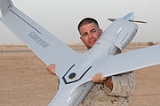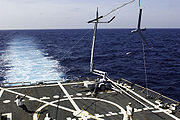
ScanEagle
Encyclopedia
ScanEagle is a small, low-cost, long-endurance unmanned aerial vehicle
(UAV) built by Insitu
, a subsidiary of Boeing
. The ScanEagle was designed by Insitu and continues to be upgraded with improved technology and designed-in reliability improvements.
. ScanEagle emerged as the result of a strategic alliance between Boeing and Insitu. The resulting technology has been successful as a portable Unmanned Aerial System (UAS) for autonomous surveillance in the battlefield, and has been deployed since August 2004 in the Iraq War.
ScanEagle carries a stabilized electro-optical and/or infrared camera on a light-weight inertially stabilized turret system integrated with communications range over 100 km, and flight endurance of 20+ hours. ScanEagle has a 10 feet (3 m) wingspan and can fly up to 75 knots (147 km/h), with an average cruising speed of 60 knots (118 km/h). Block D aircraft featured a higher resolution camera, a custom-designed Mode C transponder
and a new video system. A Block D aircraft, flying at Boeing's test range in Boardman, Oregon
set a type endurance record of 22 hours, 8 minutes.
ScanEagle needs no airfield for deployment. Instead, it is launched using a pneumatic launcher designed as part of a university engineering design project, now patented by Insitu as the "SuperWedge" launcher. It is recovered using the "SkyHook" retrieval system, which uses a hook on the end of the wingtip to catch a rope hanging from a 30 to 50 feet (15 m) pole. This is made possible by a high-quality differential GPS units mounted on the top of the pole and UAV. The rope is attached to a shock cord to reduce stress on the airframe imposed by the abrupt stop.
In August 2010, Boeing announced plans to control ScanEagles from control stations on E-3A AWACS aircraft and on the V-22.
In July 2011, a team of two ScanEagles and another UAV cooperated to search and navigate a mountain area autonomously.
 The ScanEagle entered service with the U.S. Navy in 2005. In addition to the United States military, the Australian Army also operates the ScanEagle UAV. As well the Canadian Government announced in August 2008 that they would lease the ScanEagle for use of their military operations in Afghanistan.
The ScanEagle entered service with the U.S. Navy in 2005. In addition to the United States military, the Australian Army also operates the ScanEagle UAV. As well the Canadian Government announced in August 2008 that they would lease the ScanEagle for use of their military operations in Afghanistan.
On 18 March 2008, Boeing, with ImSAR and Insitu successfully flight-tested a ScanEagle with a Nano-SAR radar mounted aboard. The Nano-SAR is the world's smallest Synthetic Aperture Radar
, weighs two pounds and is roughly the size of a shoe box. It is designed to provide high quality real-time ground imaging through adverse weather conditions or other battlefield obscurants.
 In April 2009 a ScanEagle launched by the US Navy was used during the stand-off between the US Navy and a lifeboat controlled by pirates holding Capt. Richard Phillips of the MV Maersk Alabama
In April 2009 a ScanEagle launched by the US Navy was used during the stand-off between the US Navy and a lifeboat controlled by pirates holding Capt. Richard Phillips of the MV Maersk Alabama
in the Indian Ocean after a failed hijack attempt
.
Insitu announced that the ScanEagle had totaled 500,000 combat flight hours and over 56,000 sorties in July 2011.
: Royal Canadian Air Force
: Royal Netherlands Army
: Italian Navy
Unmanned aerial vehicle
An unmanned aerial vehicle , also known as a unmanned aircraft system , remotely piloted aircraft or unmanned aircraft, is a machine which functions either by the remote control of a navigator or pilot or autonomously, that is, as a self-directing entity...
(UAV) built by Insitu
Insitu
Insitu, Inc. is an American company headquartered in Bingen, Washington that builds Unmanned aerial vehicles . On July 22, 2008, it was announced that Insitu would be acquired by long-time partner Boeing.-History:...
, a subsidiary of Boeing
Boeing
The Boeing Company is an American multinational aerospace and defense corporation, founded in 1916 by William E. Boeing in Seattle, Washington. Boeing has expanded over the years, merging with McDonnell Douglas in 1997. Boeing Corporate headquarters has been in Chicago, Illinois since 2001...
. The ScanEagle was designed by Insitu and continues to be upgraded with improved technology and designed-in reliability improvements.
Design and development
ScanEagle is a descendant of another Insitu UAV, SeaScan, which was conceived of as a remote sensor for collecting weather data as well as helping commercial fishermen locate and track schools of tunaTuna
Tuna is a salt water fish from the family Scombridae, mostly in the genus Thunnus. Tuna are fast swimmers, and some species are capable of speeds of . Unlike most fish, which have white flesh, the muscle tissue of tuna ranges from pink to dark red. The red coloration derives from myoglobin, an...
. ScanEagle emerged as the result of a strategic alliance between Boeing and Insitu. The resulting technology has been successful as a portable Unmanned Aerial System (UAS) for autonomous surveillance in the battlefield, and has been deployed since August 2004 in the Iraq War.
ScanEagle carries a stabilized electro-optical and/or infrared camera on a light-weight inertially stabilized turret system integrated with communications range over 100 km, and flight endurance of 20+ hours. ScanEagle has a 10 feet (3 m) wingspan and can fly up to 75 knots (147 km/h), with an average cruising speed of 60 knots (118 km/h). Block D aircraft featured a higher resolution camera, a custom-designed Mode C transponder
Transponder (aviation)
A transponder is an electronic device that produces a response when it receives a radio-frequency interrogation...
and a new video system. A Block D aircraft, flying at Boeing's test range in Boardman, Oregon
Boardman, Oregon
Boardman is a city in Morrow County, Oregon, United States on the Columbia River and Interstate 84. As of the 2010 census the population was 3,220. It is part of the Pendleton–Hermiston Micropolitan Statistical Area.-History:...
set a type endurance record of 22 hours, 8 minutes.
ScanEagle needs no airfield for deployment. Instead, it is launched using a pneumatic launcher designed as part of a university engineering design project, now patented by Insitu as the "SuperWedge" launcher. It is recovered using the "SkyHook" retrieval system, which uses a hook on the end of the wingtip to catch a rope hanging from a 30 to 50 feet (15 m) pole. This is made possible by a high-quality differential GPS units mounted on the top of the pole and UAV. The rope is attached to a shock cord to reduce stress on the airframe imposed by the abrupt stop.
Improvements
In 2009, Boeing and Insitu announced the NightEagle, a modified Block E ScanEagle with an infrared camera for night operations.In August 2010, Boeing announced plans to control ScanEagles from control stations on E-3A AWACS aircraft and on the V-22.
In July 2011, a team of two ScanEagles and another UAV cooperated to search and navigate a mountain area autonomously.
Operational history

On 18 March 2008, Boeing, with ImSAR and Insitu successfully flight-tested a ScanEagle with a Nano-SAR radar mounted aboard. The Nano-SAR is the world's smallest Synthetic Aperture Radar
Synthetic aperture radar
Synthetic-aperture radar is a form of radar whose defining characteristic is its use of relative motion between an antenna and its target region to provide distinctive long-term coherent-signal variations that are exploited to obtain finer spatial resolution than is possible with conventional...
, weighs two pounds and is roughly the size of a shoe box. It is designed to provide high quality real-time ground imaging through adverse weather conditions or other battlefield obscurants.

MV Maersk Alabama
MV Maersk Alabama is a container ship owned by Maersk Line Limited and operated by Waterman Steamship Corporation....
in the Indian Ocean after a failed hijack attempt
Maersk Alabama hijacking
The Maersk Alabama hijacking was a series of events involving piracy that began with four Somali pirates seizing the cargo ship southeast of the Somali port city of Eyl. This event ended with the action of 12 April 2009. It was the first successful pirate seizure of a ship registered under the...
.
Insitu announced that the ScanEagle had totaled 500,000 combat flight hours and over 56,000 sorties in July 2011.
Operators
: Australian Defence ForceAustralian Defence Force
The Australian Defence Force is the military organisation responsible for the defence of Australia. It consists of the Royal Australian Navy , Australian Army, Royal Australian Air Force and a number of 'tri-service' units...
: Royal Canadian Air Force
Royal Canadian Air Force
The history of the Royal Canadian Air Force begins in 1920, when the air force was created as the Canadian Air Force . In 1924 the CAF was renamed the Royal Canadian Air Force and granted royal sanction by King George V. The RCAF existed as an independent service until 1968...
: Royal Netherlands Army
Royal Netherlands Army
The Royal Netherlands Army is the land forces element of the military of the Netherlands.-Short history:The Royal Netherlands Army was raised on 9 January 1814, but its origins date back to 1572, when the so-called Staatse Leger was raised...
: Italian Navy
Italian Navy
Italian Navy may refer to:* Pre-unitarian navies of the Italian states* Regia Marina, the Royal Navy of the Kingdom of Italy * Italian Navy , the navy of the Italian Republic...
External links
- ScanEagle product page on Insitu.com
- ScanEagle page on Boeing.com
- Video of ScanEagle takeoff and caputure on Insitu.com
- Boeing/Insitu ScanEagle background page on CASR site
- "ScanEagle Proves Worth in Fallujah Fight". DefenseLink.mil
- "ScanEagle finds 'sweet spot' as globally ubiquitous airborne sensor". Flight Daily News
- Dutch military to phase in ScanEagle

